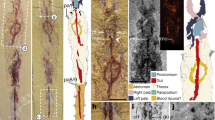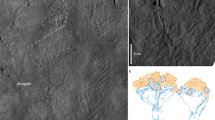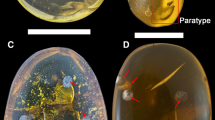Abstract
Exceptional fossil preservation is critical to our understanding of early metazoan evolution. A key source of information is the Burgess Shale-type faunas1,2,3,4,5. Fossils from these deposits provide important insights into metazoan phylogeny, notably that of stem-group protostomes2,3,6, and related topics such as trophic specialization7. Metazoan relationships are also being significantly reappraised in terms of molecular-based phylogenies8,9, but integration of these data with palaeontological systematics is not straightforward10,11. Moreover, molecular phylogenies are silent concerning the anatomies of stem-groups and the functional transitions that underpin the origin of different body plans2,6. Some hitherto enigmatic fossils possess unique character–state combinations that, although they can be shoe-horned into extinct phyla12, may be more profitably interpreted as defining major stem-groups2,3. Here we describe a possible pipiscid, a metazoan previously known only from the Upper Carboniferous13,14, from the Lower Cambrian of south China. Pipiscids are currently interpreted as being agnathan chordates13,14,15, but this discovery from the Chengjiang fossil-Lagerstätte indicates that the assignment of pipiscids to the Agnatha deserves to be reconsidered.
This is a preview of subscription content, access via your institution
Access options
Subscribe to this journal
Receive 51 print issues and online access
$199.00 per year
only $3.90 per issue
Buy this article
- Purchase on Springer Link
- Instant access to full article PDF
Prices may be subject to local taxes which are calculated during checkout


Similar content being viewed by others
References
Conway Morris, S. The Crucible of Creation: The Burgess Shale and the Rise of Animals (Oxford Univ. Press, Oxford, (1998).
Conway Morris, S. & Peel, J. S. Articulated halkieriids from the Lower Cambrian of North Greenland and their role in early protostome evolution. Phil. Trans. R. Soc. Lond. B 347, 305–358 (1995).
Budd, G. E. in Arthropod Relationships (eds Fortey, R. A. & Thomas, R. H.) Syst. Ass. Spec. Vol. 55, 125–138 (1997).
Chen, J-Y. et al. The Chengjiang Biota (National Museum of Natural Science, Taiwan, c. (1996).
Chen, J-Y. & Zhou, G-Q. Biology of the Chengjiang fauna. Bull. Natl Mus. Nat. Sci. Taiwan 10, 11–105 (1997).
Budd, G. E. The morphology of Opabinia regalis and the reconstruction of the arthropod stem-group. Lethaia 29, 1–14 (1996).
Butterfield, N. J. Burgess Shale-type fossils from a Lower Cambrian shallow-shelf sequence in northwestern Canada. Nature 369, 477–479 (1994).
de Rosa, R. et al. Hox genes in brachiopods and priapulids and protostome evolution. Nature 399, 772–776 (1999).
Ruiz-Trillo, I. et al. Acoel flatworms: Earliest extant bilaterian metazoans, not members of platyhelminthes. Science 283, 1919–1923 (1999).
Conway Morris, S. Why molecular biology needs palaeontology. Development(Suppl.) 1994, 1–13 (1994).
Conway Morris, S. Metazoan phylogenies: falling into place or falling to pieces? A palaeontological perspective. Curr. Op. Genet. Dev. 8, 662–667 (1998).
Gould, S. J. Wonderful Life: The Burgess Shale and the Nature of History (Norton, New York, (1989).
Bardack, D. & Richardson, E. S. New agnathous fishes from the Pennsylvanian of Illinois. Fieldiana Geol. 33, 489–510 (1977).
Bardack, D. in Richardson's Guide to the Fossil Fauna of Mazon Creek (eds Shabica, C. W. & Hay, A. A.) 226–243 (Northeastern Illinois Univ. Press, Chicago, (1997).
Janvier, P. Early Vertebrates (Clarendon, Oxford, (1996).
Chen, J-Y. et al. Apossible early Cambrian chordate. Nature 377, 720–722 (1995).
Chen, J-Y. & Li, C-W. Early Cambrian chordate from Chengjiang, China. Bull. Natl Mus. Nat. Sci. Taiwan 10, 257–273 (1997).
Dzik, J. Yunnanozoon and the ancestry of chordates. Acta Palaeont. Pol. 40, 341–360 (1995).
Shu, D., Zhang, X-L. & Chen, L. Reinterpretation of Yunnanozoon as the earliest known hemichordate. Nature 380, 428–430 (1996).
Collins, D. The “evolution” of Anomalocaris and its classification in the arthropod class Dinocarida (nov.) and order Radiodonta (nov.). J. Paleont. 70, 280–293 (1996).
Nachtigall, W. Biological Mechanisms of Attachment (Springer, Berlin, (1974).
Packard, A. in The Mollusca, Form and FunctionVol. 11 (eds Trueman, E. R. & Clarke, M. R.) 37–67 (Academic, San Diego, (1988).
Conway Morris, S. Typhloesus wellsi (Melton and Scott, 1973), a bizarre metazoan from the Carboniferous of Montana, USA. Phil. Trans. R. Soc. Lond. B 327, 595–624 (1990).
Johnson, R. G. & Richardson, E. S. Pennsylvanian invertebrates of the Mazon Creek area, Illinois: The morphology and affinities of Tullimonstrum. Fieldiana Geol. 12, 119–149 (1969).
Holland, L. Z. & Holland, N. D. Developmental gene expression in Amphioxus: New insights into the evolutionary origin of vertebrate brain regions, neural crest, and rostrocaudal segmentation. Am. Zool. 38, 647–658 (1998).
Acknowledgements
We thank the National Foundation of Natural Sciences of China, Minister of Science and Technology of China, Royal Society, National Geographic Society, and St John's College, Cambridge for support. Access to Pipiscius was facilitated by P. Crane (Field Museum, Chicago), and M. P. Smith and P. Donoghue (University of Birmingham). Technical assistance by S. J. Last and D. R. Simons is acknowledged, as are critical comments by P. Janvier, D. B. Norman and S. Jensen.
Author information
Authors and Affiliations
Corresponding author
Rights and permissions
About this article
Cite this article
Shu, D., Morris, S., Zhang, XL. et al. A pipiscid-like fossil from the Lower Cambrian of south China. Nature 400, 746–749 (1999). https://doi.org/10.1038/23445
Received:
Accepted:
Issue Date:
DOI: https://doi.org/10.1038/23445
This article is cited by
-
Symbiotic fouling of Vetulicola, an early Cambrian nektonic animal
Communications Biology (2020)
-
Meiofaunal deuterostomes from the basal Cambrian of Shaanxi (China)
Nature (2017)
-
Evidence for gill slits and a pharynx in Cambrian vetulicolians: implications for the early evolution of deuterostomes
BMC Biology (2012)
-
Preliminary notes on soft-bodied fossil concentrations from the Early Cambrian Chengjiang deposits
Chinese Science Bulletin (2006)
-
On the Phylum Vetulicolia
Chinese Science Bulletin (2005)
Comments
By submitting a comment you agree to abide by our Terms and Community Guidelines. If you find something abusive or that does not comply with our terms or guidelines please flag it as inappropriate.



